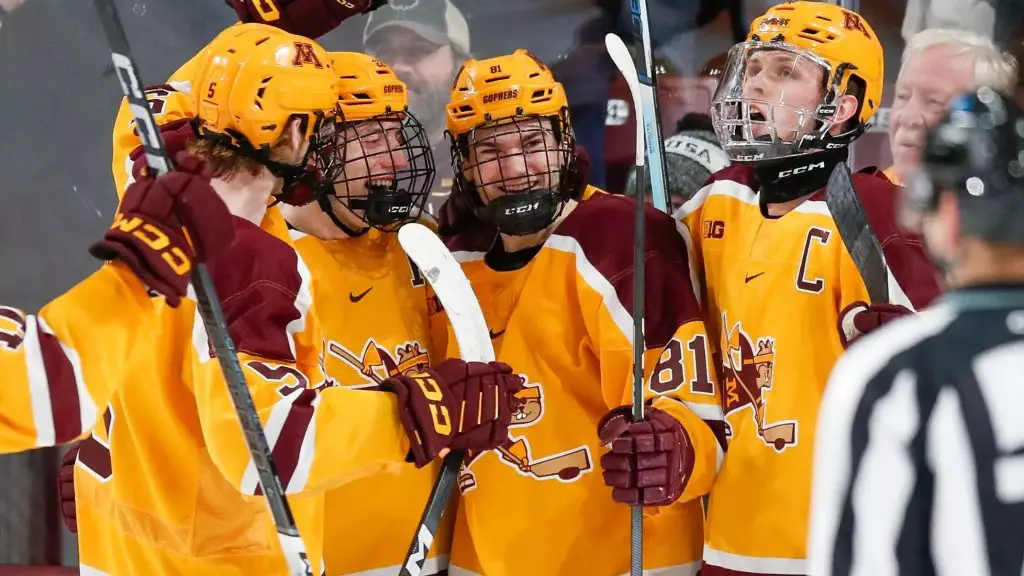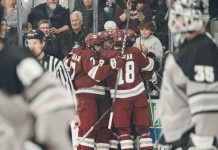
Each week during the season, we look at the big events and big games around Division I men’s college hockey in Tuesday Morning Quarterback.
Dan: A hearty good morning to you all, and an especially happy Tuesday to my good buddy Ed, to whom we’re sharing TMQ duties this week.
It was a wild, incredible weekend of hockey exemplified by a couple of different storylines that we actually discussed at length before we ever sat down for this one.
Ed, we can start literally anywhere here, and I’m sure we’ll get to the majority of it before this done, but I want to start with the World Juniors and Team USA’s 6-2 win over Sweden. I recall specifically saying that the Americans needed to play with that edge that makes them American – the red, white and blue swagger associated with why international countries usually hate seeing USA win gold medals in anything. I wanted to see them march into the arena really embracing the devil’s due of being the enemy on that ice, and I was deeply rewarded by watching that team walk out with the gold. The key word there being team because I felt like the Americans gelled as the tournament progressed.
In the end, I found myself practically doing the chant on my couch at home with them. From a pure hockey standpoint, what stood out to you about this American side?
Ed: Dan, I agree about the team becoming better as the tournament went on, and about the swagger. I’m usually not a big fan of fighting but I loved seeing Lane Hutson take on a much bigger Anton Johannson in some admittedly unnecessary late-game fisticuffs, putting an exclamation point on USA’s bravado.
I guess there were two things that stood out for me on this team on the ice. First, just the skill level. We’ve talked a lot in this column about the crazy abilities of modern players to shoot and skate. But putting all of those 2004 and 2005 birth-year players together on one team really showed how the game has progressed in the U.S., and how much of an impact the U.S. National Development Program has had.
I was also impressed by the team’s resilience. The team didn’t really face “adversity” (a word I cringe a little about using compared to real human adversity) but they did come back in a couple of situations. Team USA had to come from behind twice against Czechia and ultimately prevailed with Isaac Howard’s seventh-round shootout goal. The Americans also recovered from a somewhat sluggish first period and a 2-0 deficit in the semifinals against Finland.
The U.S. team’s success also said a lot about the state of college hockey. With all but three players coming from the NCAA ranks, and an all-college coaching staff led by Denver’s David Carle, it showed the world just how good D-I men’s hockey is.
Speaking of college hockey, play slowly got back underway last weekend, although teams with players in the WJC smartly scheduled exhibitions, bye weekends, or at the very least nonconference games. What from this past weekend jumps out at you?
Dan: I was trying to work an alphabet joke into this, but I’ll just come out and say it: Air Force and Yale deserve some serious headlines after what they did this weekend.
Let me start with Air Force because I had a front-row seat to what the Falcons accomplished with their weekend sweep at Bentley. Last month, the Massachusetts-based Falcons went west and took four points from Air Force with an overtime loss and a 3-0 win, but the second game sent the cadets into a bit of a tailspin over the next few weeks (no pun intended). While it’s true that they had to play both Wisconsin and Minnesota Duluth – no easy task – they lost both games in their holiday tournament by a combined 7-1 score, and dating back to mid-November, Air Force failed to score more than two goals in regulation in seven straight games. The team that scored five against Mercyhurst seemingly lost its lightning bolts, and the lack of points sent them tumbling down the Atlantic Hockey standings table.
Winning both of those games at Bentley – and dominating one of the best statistical defenses in the country in the process – included a milestone when Will Gavin scored a hat trick exclusively on the power play on Saturday night. Full credit here to Todd Bell in the AHA offices, but it was the fourth time that ever happened and tied a league record for goals in a single power play. Outside of stealing the thunder that I’m sure Chris Lerch is going to use this week for his weekly piece on these pages, it also vaulted Air Force into sixth after it started the weekend in one of those first round road spots.
As for Yale, I’m leaking my own lead for ECAC here, but the Bulldogs went from last to fourth in one weekend’s worth of work after sweeping their trip to the Capital District. In both instances, they had to show some major resilience in beating RPI and Union, and because of ECAC’s parity, a team that started the second half in a tie for 12th place was able to move into fourth with a shot at second.
Maybe that’s a teaser for the upcoming week, but those are two WILD numbers for me. They’re also two teams that absolutely nobody had on their weekend bingo cards.
Embedded within that argument is, of course, the constant argument that ECAC is fighting things this year, but it seems extraordinarily strange that a league would have that much of a packed table to allow a team to move eight spots with six points. I’m admittedly worried for the league this year because it scored four spots in the national tournament last year and is likely headed for one unless someone beats Quinnipiac in the postseason. I’d even go so far as to say that Atlantic Hockey is having a better regular season, and I think I’d be statistically correct.
Is this a sign of something in college hockey, or is this something that’s an aberration?
Ed: Parity isn’t always a signal that everyone is good; sometimes it’s a sign that everyone is sort of “mid” as the kids say these days. I think maybe what we’re seeing with the ECAC is a bit of a hangover from eight of its 12 teams taking a year off during COVID, plus the Ivies not being able to take fifth-year players. Both of those will correct themselves in another year or two … I hope.
To address your question as to whether this is a sign of something in college hockey? It might be.
We’re seeing the results of a few things this season. I already mentioned a couple of reasons why the ECAC may have stepped back a bit. Things are down in the CCHA as well, and part of it is that Minnesota State is recovering from Mike Hastings’ departure. And that’s not a shot at Luke Strand by any means, especially since a few players and recruits also made the trip from Mankato to Madison. But the overall winning percentage of the league in non-conference play has been buoyed by the Mavericks in past seasons, and a rising out-of-conference record lifts all PairWise boats.
Another factor that I think is overlooked is that this is now the fourth year of a full complement of 18 scholarships in Atlantic Hockey. As of this writing, that conference is .368 in non-conference play. That’s still below the .400 or better that’s likely necessary for an at-large bid in addition to the automatic qualifier – though RIT still has a chance – but it’s the best that the league has seen in its evolution from a humble-by-design start as a cost-containment conference.
The other part of the equation is just how good the other three conferences have been out of conference. And so I’ll ask you: Is the other side of the coin going to be a continued pre-eminence of the Big Ten, Hockey East, and the NCHC?
Dan: I don’t think those three leagues are ever going to slide back into the ether, but I think the context around the conversation provides insight into why that’s going to happen.
Think about how Hockey East only had two teams in the NCAA tournament last year and compare that to Atlantic Hockey or the CCHA. Like you said, the CCHA (and the WCHA before that) very obviously built on Minnesota State’s overall success as a meal ticket in the PairWise Rankings, but getting a second team and an at-large bid into the national tournament is something that’s only happened once in Atlantic Hockey history. In contrast, the NCHC, Big Ten and Hockey East would feel like the season was an abject failure if any of those leagues only had one team, and even last year’s Hockey East – which had two, one year after the 2022 tournament had three, none of which were better than a No. 3 seed – felt like a down year.
That context is rooted in the size of the leagues and their ability to generate revenue, which we all know is a disparity between the conferences. Throw in the transfer portal for good measure there, but I don’t see the gap closing any time soon. I do worry that NIL will gradually leak its way into college hockey – it already has – and that’s going to cause even more disparity because the bigger schools affiliated with Division I or Division I power conferences are going to have the resources and tools to get student-athletes into the NIL deals that other schools don’t currently have. While I agree that NIL is important and is a tool that the athletes deserve to use, I also worry about Division II play-up schools or old Division III schools grandfathered into college hockey and if they’re going to have the resources to keep up with NIL once it lands for good.
It’s actually a really good question that you’re asking because that’s the devil on my shoulder. My angel on the other shoulder reminds me that college hockey is deeper than ever, and the constant growth of the game is actually loading that underbelly with better, more talented players and teams. Quinnipiac won the national championship last year, and Minnesota State and St. Cloud came within a game of winning national titles in the two previous years. We’re a decade removed from Union and Yale winning national championships, and it’s been eight years since North Dakota won a title, 12 years since Boston College won one, 15 years since BU’s last tie, and 21 years since the Gophers last hoisted the trophy. Ferris State played for a national championship more recently than Michigan, though it’s only by a year, and RIT has as many Frozen Four appearances in the last 15 years as Wisconsin – shoutout the 2010 Frozen Four matchup between the two teams in Detroit.
Maybe hockey’s the one sport that’s a little more immune to all of this, but it’s very dialectical. Both can occur at the same time. We can have a Hockey East, NCHC, Big Ten run of dominance…and we can have parity and growth of the game all at the same time.
I’ll kick this over to you to close this one out for us, but as the second half begins in earnest this month, let’s look into the crystal ball. Tell me one thing that you think could really happen in the second half among those three leagues, since it’s increasingly shaping up that they’re our focal point as the tournament gets closer.
Ed: It’s possible that one of those three leagues could still slip up and not get more than two teams into the NCAA tournament. A bit of cannibalism can still happen if some teams inside the bubble but near the edge converge on a .500 record. As we write this on Monday night, we’re still waiting for the results of Minnesota-Colorado College (Minnesota won 6-2), but both the Golden Gophers and Michigan have the predicament of a precarious PairWise position.
If things play out such that defending champion Quinnipiac doesn’t win the ECAC regular season and there are two teams from that conference, while Atlantic Hockey and CCHA both get one team in, that would leave out every at-large below No. 12. Figure in just one upset in one of the three leagues, and you’re at No. 11. (And that doesn’t even figure in Arizona State if the Sun Devils win most of the rest of their schedule.)
That’s my predicition for this March. Those three leagues will divvy up the 10 or 11 spots available, and three or four very good teams will be watching the tournament on ESPN.


